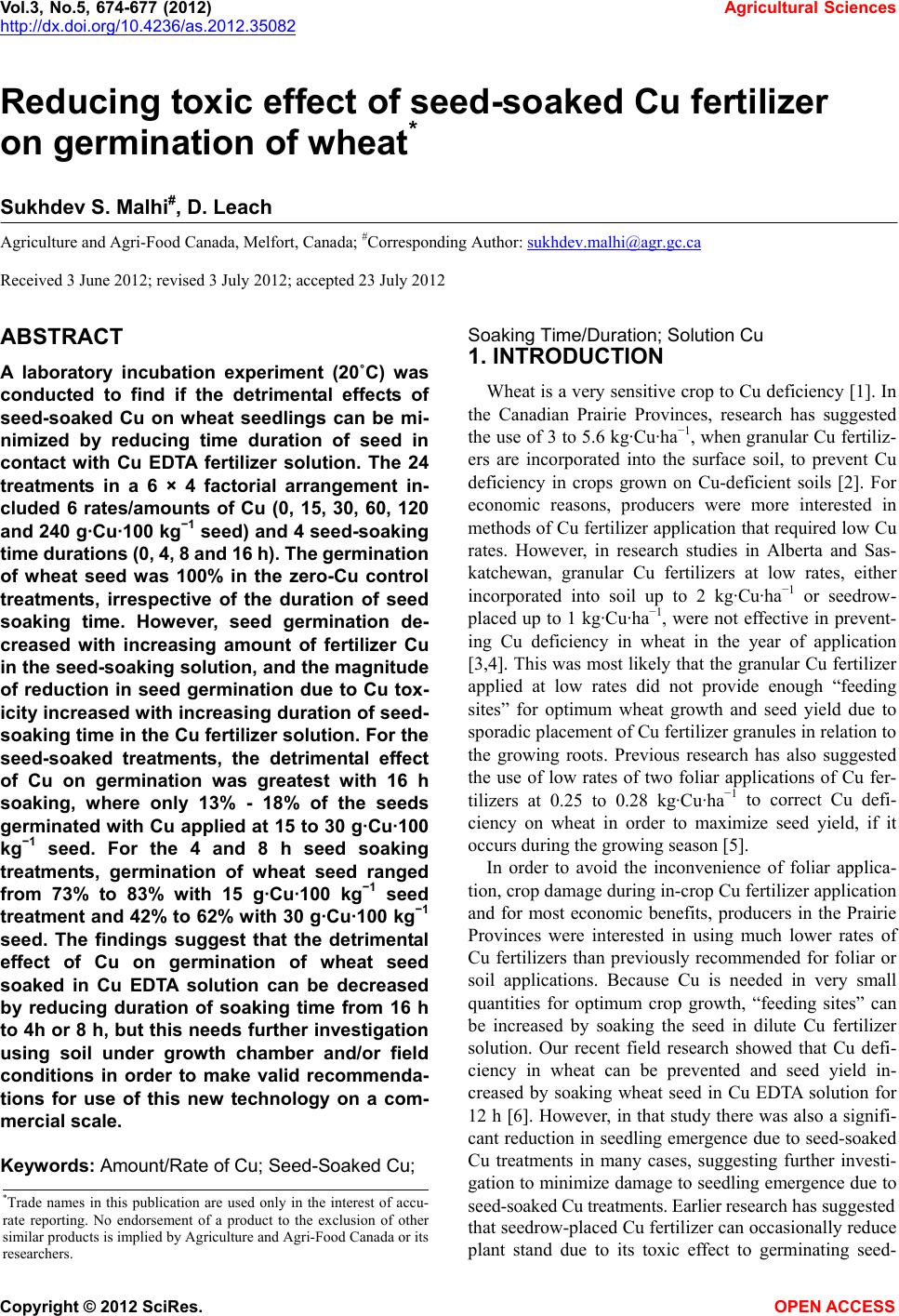
Vol.3, No.5, 674-677 (2012) Agricultural Sciences
http://dx.doi.org/10.4236/as.2012.35082
Reducing toxic effect of seed-soaked Cu fertilizer
on germination of wheat*
Sukhdev S. Malhi#, D. Leach
Agriculture and Agri-Food Canada, Melfort, Canada; #Corresponding Author: sukhdev.malhi@agr.gc.ca
Received 3 June 2012; revised 3 July 2012; accepted 23 July 2012
ABSTRACT
A laboratory incubation experiment (20˚C) was
conducted to find if the detrimental effects of
seed-soaked Cu on wheat seedlings can be mi-
nimized by reducing time duration of seed in
contact with Cu EDTA fertilizer solution. The 24
treatments in a 6 × 4 factorial arrangement in-
cluded 6 rates/amounts of Cu (0, 15, 30, 60, 120
and 240 g·Cu·100 kg−1 seed) and 4 seed-soaking
time durations (0, 4, 8 and 16 h). The germination
of wheat seed was 100% in the zero-Cu control
treatments, irrespective of the duration of seed
soaking time. However, seed germination de-
creased with increasing amount of fertilizer Cu
in the seed-soaking solution, and the magnitude
of reduction in seed germination due to Cu tox-
icity increased with increasing duration of seed-
soaking time in the Cu fertilizer solution. For the
seed-soaked treatments, the detrimental effect
of Cu on germination was greatest with 16 h
soaking, where only 13% - 18% of the seeds
germinated with Cu applied at 15 to 30 g·Cu·100
kg−1 seed. For the 4 and 8 h seed soaking
treatments, germination of wheat seed ranged
from 73% to 83% with 15 g·Cu·100 kg−1 seed
treatment and 42% to 62% with 30 g·Cu·100 kg−1
seed. The findings suggest that the detrimental
effect of Cu on germination of wheat seed
soaked in Cu EDTA solution can be decreased
by reducing duration of soaking time from 16 h
to 4h or 8 h, but this needs further investigation
using soil under growth chamber and/or field
conditions in order to make valid recommenda-
tions for use of this new technology on a com-
mercial scale.
Keywords: Amount/Rate of Cu; Seed-Soaked Cu;
Soaking Time/Duration; Solution Cu
1. INTRODUCTION
Wheat is a very sensitive crop to Cu deficiency [1]. In
the Canadian Prairie Provinces, research has suggested
the use of 3 to 5.6 kg·Cu·ha−1, when granular Cu fertiliz-
ers are incorporated into the surface soil, to prevent Cu
deficiency in crops grown on Cu-deficient soils [2]. For
economic reasons, producers were more interested in
methods of Cu fertilizer application that required low Cu
rates. However, in research studies in Alberta and Sas-
katchewan, granular Cu fertilizers at low rates, either
incorporated into soil up to 2 kg·Cu·ha−1 or seedrow-
placed up to 1 kg·Cu·ha−1, were not effective in prevent-
ing Cu deficiency in wheat in the year of application
[3,4]. This was most likely that the granular Cu fertilizer
applied at low rates did not provide enough “feeding
sites” for optimum wheat growth and seed yield due to
sporadic placement of Cu fertilizer granules in relation to
the growing roots. Previous research has also suggested
the use of low rates of two foliar applications of Cu fer-
tilizers at 0.25 to 0.28 kg·Cu·ha−1 to correct Cu defi-
ciency on wheat in order to maximize seed yield, if it
occurs during the growing season [5].
In order to avoid the inconvenience of foliar applica-
tion, crop damage during in-crop Cu fertilizer application
and for most economic benefits, producers in the Prairie
Provinces were interested in using much lower rates of
Cu fertilizers than previously recommended for foliar or
soil applications. Because Cu is needed in very small
quantities for optimum crop growth, “feeding sites” can
be increased by soaking the seed in dilute Cu fertilizer
solution. Our recent field research showed that Cu defi-
ciency in wheat can be prevented and seed yield in-
creased by soaking wheat seed in Cu EDTA solution for
12 h [6]. However, in that study there was also a signifi-
cant reduction in seedling emergence due to seed-soaked
Cu treatments in many cases, suggesting further investi-
gation to minimize damage to seedling emergence due to
seed-soaked Cu treatments. Earlier research has suggested
*Trade names in this publication are used only in the interest of accu-
rate reporting. No endorsement of a product to the exclusion of othe
similar products is implied by Agriculture and Agri-Food Canada or its
researchers.
that seedrow-placed Cu fertilizer can occasionally reduce
plant stand due to its toxic effect to germinating seed-
Copyright © 2012 SciRes. OPEN ACCESS